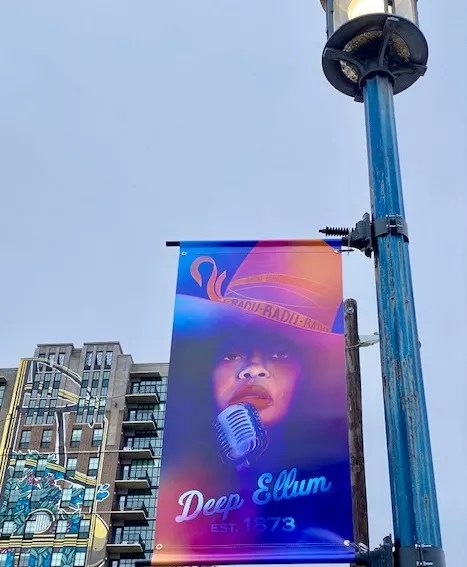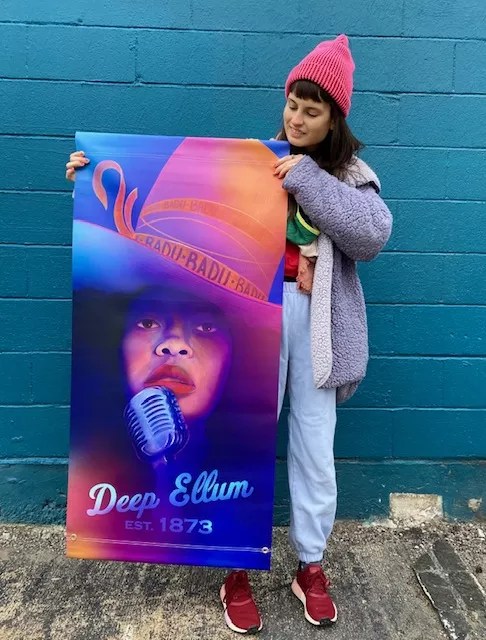
Brooklynd Turner

Audio By Carbonatix
Leafy stems ascend across a banner in Deep Ellum while the roots below seem to search freely. The artwork, created by Shamsy, a local artist drawn to the outdoors and natural world, is one of six banners designed for the Deep Roots project celebrating both Black History Month and Women’s History Month.
“Deep Ellum,” reads part of one vibrant banner fashioned by Dallas artist Ebony Lewis, “Powerful since 1873.”
Brandy Michele Adams, owner of WAAS Gallery, curated the artwork, which is displayed on Elm and Main Streets, between Good Latimer and Exposition.
“For me, the fact that it was both Black History Month and Women’s History Month was very important,” says Molly Sydnor, 28, who lived in Deep Ellum for a while and identifies as a woman of color.
This year, make your gift count –
Invest in local news that matters.
Our work is funded by readers like you who make voluntary gifts because they value our work and want to see it continue. Make a contribution today to help us reach our $30,000 goal!
“I’m biracial,” she says, before adding that she’s “half Black.”
Sydnor’s colorful banner depicts legendary blues singer Bessie Smith, whose style influenced Janis Joplin.
Smith was the highest-paid Black performer of her day and by the end of the 1920s had earned the title “Empress of the Blues,” according to biography.com.
While Sydnor’s depiction of Smith is colorful, the artist says “in the same sense, it’s kind of monochromatic. Her face is in oranges and her scarf is in yellows … her hair is blue.”

Artist Brooklynd Turner holding her banner of Erykah Badu for the Deep Roots project in Deep Ellum.
Rob Wrinkle
A red, white, blue and black banner created by Jeremy Biggers, 39, portrays folk musician and bluesman Huddie Ledbetter, better known as Lead Belly, whose skill influenced musicians such as The Beatles and Kurt Cobain.
“I thought it would be fitting for it to be somebody that was integral to the growth and the development of the Deep Ellum that we know today,” he says, noting that while lots of people have had a tremendous impact on the community, he wanted his illustration to represent someone from the early stages of Deep Ellum history.
Lead Belly was born on a plantation in Louisiana in the 1880s and eventually made his way to Dallas where he played with Blind Lemon Jefferson. After becoming acquainted with the law, Lead Belly served time in Huntsville as well as the Louisiana state penitentiary Angola where he played guitar and sang on Sundays as well as in his spare time, according to the National Park Service’s webpage on the lower Mississippi Delta region.
“When folklorist John Lomax arrived at Angola with his son Alan in July 1933 to record ‘Negro work songs’ for the Library of Congress, Warden Jones recommended [Lead Belly],” says nps.gov. “The Lomaxes were so impressed with Lead Belly’s ability that they returned a year later to record him again, several months before his release for “good time.”
In addition, a banner illustrated by JD Moore depicts William Pittman, an architect who graduated from Tuskegee University where he later taught architecture.
Pittman, who had married Portia Washington, Booker T. Washington’s daughter, eventually moved to Dallas where he continued designing notable structures like the Knights of Pythias Temple, which was built in 1916. Now home of the Pittman Hotel, the Beaux Arts-style building is located at 2551 Elm St.
Pittman also published a weekly paper, The Brotherhood Eyes, which cost him his freedom when “a federal grand jury in Dallas indicted Pittman on charges of using the U.S. mail to distribute material it considered ‘obscene, lewd, lascivious and of an indecent character,'” in 1937.
The architect and publisher died in Dallas in 1958.
Artist Brooklynd Turner, art director at WAAS Gallery, says she chose to honor Erykah Badu in her illustration “because of her Dallas roots, spiritual message and global influence.”
“I admire artists such as her, women who witnessed years of the beauty and tragedy of a city, and fought to convey their message of peace,” reads Turner’s artist statement.
Turner’s banner conveys Badu performing in a 10-gallon hat with her hair flowing through stage lights.
“It kind of captured the feeling of Deep Ellum,” she says of the banner’s blue tones. “Because blue is a nighttime color and that’s when the city comes to life on that street, and that’s when the artists would be performing.”